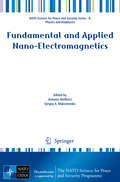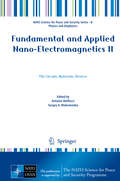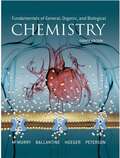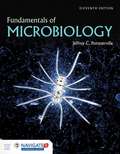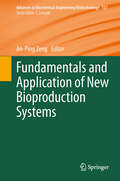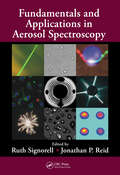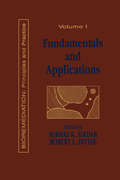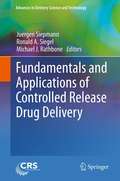- Table View
- List View
Fundamental Studies of Shock-Driven Hydrodynamic Instabilities (Springer Theses)
by Yu LiangThis book illustrates the latest progress on the hydrodynamic instabilities induced by a shock wave, particularly RM (Richtmyer–Meshkov) instability. The hydrodynamic instabilities play crucial roles in various industrial and scientific fields, such as inertial confinement fusion, supersonic combustion, supernova explosion, etc. This book experimentally and theoretically explores the shock-driven instabilities of complex gas-gas and gas-liquid interfaces. The main difficulty in performing an experimental study on RM instability, especially in a shock-tube circumstance, lies in creating an idealized initial interface because the RM instability is extremely sensitive to the initial condition. This book introduces new experimental methods to generate shape-controllable two-dimensional gaseous interfaces, thickness-controllable gas layers, and water droplets embedded with a vapour bubble in the shock-tube experiments. It covers the latest experiments and theories on the shock-driven hydrodynamic instabilities of multi-mode, multi-layer, and multi-phase interfaces. It explores the effects of the mode-competition, interface-coupling, and phase-transition on interface evolution, respectively. This book establishes a universal nonlinear theory to predict the RM instability of a shocked multi-mode interface based on spectrum analysis. This book quantifies the effects of interface-coupling and reverberating waves on the hydrodynamic instabilities of a shocked multi-layer interface. This book provides the experimental studies of the interaction of a shock wave and a multi-phase droplet and proposes a modified Rayleigh-Plesset equation to predict the vapour bubble collapse inside a droplet.
Fundamental and Applied Nano-Electromagnetics
by Antonio Maffucci Sergey A. MaksimenkoThis book presents the most relevant and recent results in the study of "Nanoelectromagnetics", a recently born fascinating research discipline, whose popularity is fast arising with the intensive penetration of nanotechnology in the world of electronics applications. Studying nanoelectromagnetics means describing the interaction between electromagnetic radiation and quantum mechanical low-dimensional systems: this requires a full interdisciplinary approach, the reason why this book hosts contributions from the fields of fundamental and applied electromagnetics, of chemistry and technology of nanostructures and nanocomposites, of physics of nano-structures systems, etc. The book is aimed at providing the reader with the state of the art in Nanoelectromagnetics, from theoretical modelling to experimental characterization, from design to synthesis, from DC to microwave and terahertz applications, from the study of fundamental material properties to the analysis of complex systems and devices, from commercial thin-film coatings to metamaterials to circuit components and nanodevices. The book is intended as a reference in advanced courses for graduate students and as a guide for researchers and industrial professionals involved in nanoelectronics and nanophotonics applications.
Fundamental and Applied Nano-Electromagnetics II: THz Circuits, Materials, Devices (NATO Science for Peace and Security Series B: Physics and Biophysics)
by Antonio Maffucci Sergey A. MaksimenkoThe increasing prevalence of nanotechnologies has led to the birth of “nanoelectromagnetics,” a novel applied science related to the interaction of electromagnetic radiation with quantum mechanical low-dimensional systems. This book provides an overview of the latest advances in nanoelectromagnetics, and presents contributions from an interdisciplinary community of scientists and technologists involved in this research topic. The aspects covered here range from the synthesis of nanostructures and nanocomposites to their characterization, and from the design of devices and systems to their fabrication. The book also focuses on the novel frontier of terahertz technology, which has been expanded by the impressive strides made in nanotechnology, and presents a comprehensive overview of the: - synthesis of various nanostructured materials; - study of their electrical and optical properties; - use of nano-sized elements and nanostructures as building blocks for devices; - design and fabrication of nanotechnology devices operating in the THz, IR and optical range. The book introduces the reader to materials like nanocomposites, graphene nanoplatelets, carbon nanotubes, metal nanotubes, and silicon nanostructures; to devices like photonic crystals, microcavities, antennas, and interconnects; and to applications like sensing and imaging, with a special emphasis on the THz frequency range.
Fundamental and Applied Sciences in Asia: International Conference on Science Technology and Social Sciences (ICSTSS 2018)
by Nor Azizah Yacob Nor Yuziah Mohd Yunus Duratul Ain Tholibon Zadariana Jamil Syuhada Mohd TahirThis book gathers selected science and technology papers presented at the 2018 International Conference on Science Technology and Social Sciences (ICSTSS 2018), organised bi-annually by Universiti Teknologi MARA Pahang, Malaysia. Based on the theme “Redesigning Education for Industrial Revolution”, the papers in this book address a broad range of topics in the fundamental and applied sciences, including computer science, engineering, environmental and management, furniture, forestry, health and medicine, material science, mathematics, plantation and agrotechnology, sport science and statistics, covering theoretical, numerical and experimental studies. The book serves as a platform for disseminating research findings by academicians of local, regional and global prominence, as a catalyst to inspire positive innovations in the development of the region. It provides a significant point of reference for academicians and students: for academicians, it is a good source of information to conduct further research; for students, it is the latest point of reference on research conducted in their fields of study. The carefully reviewed papers intend to facilitate the creation of new knowledge through the exchange of ideas, strategies and innovations in various science and technology disciplines, and to contribute towards enhancing the learning environment.
Fundamental and Practical Aspects of Tribology
by Andreas Rosenkranz Diana Berman Max MarianFundamental and Practical Aspects of Tribology introduces the rudiments of engineering surfaces and teaches the basic phenomena of interacting surfaces in relative motion, major modes of friction and wear, and theories of contact evolution and lubrication. Fundamental topics include friction, wear, and lubrication; surface properties and surface topography; friction of surfaces in contact; wear and surface failures; biotribology; boundary lubrication; fluid properties; hydrodynamic lubrication; bearing selection; and introductory micro‑ and nanotribology. This book also considers the relationship between nano‑ and macrotribology, rolling contacts, tribological problems in magnetic recording and electrical contacts, and monitoring and diagnosis of friction and wear. Offers a comprehensive review of the fundamentals, providing basic information for scientists and engineers just being introduced to the tribology field Teaches tribological methods of measurements and characterization Includes examples of real‑life tribological problems and case studies of engineering problems and solutions Gives an overview of current advancements in the field Features end‑of‑chapter problems and video content for reinforcement of material This textbook is written for students taking courses in tribology and lubrication, as well as surface engineering. It will also appeal to scientists and engineers who are new to tribology.The text also offers sample laboratory demonstrations available to qualifying adopting professors.
Fundamental of Transport Phenomena and Metallurgical Process Modeling
by Sujay Kumar DuttaThis textbook presents the fundamental of transport phenomena and metallurgical process modeling in easy-to-understand format. It covers all the important and basic concepts, derivations and numerical problems for the undergraduate and graduate engineering students. It includes topics such as fluid dynamics, mass and momentum balances, mass transfer, basic concepts of models and applications. This textbook can also be used as a reference book by engineers, professionals and research scientists to gain better understanding on mass and heat balances. Given the contents, this textbook will be highly useful for the core course of transport phenomena in metallurgical processes for graduate and advanced graduate students in various engineering disciplines. This textbook will also serve as a refresher course for advanced graduate students who are engaged in research related to transport phenomena and metallurgical processes.
Fundamental: How Quantum and Particle Physics Explain Absolutely Everything
by Tim JamesA brilliantly diverting and mind-expanding guide to quantum and particle physics.At the start of the twentieth century, our knowledge of science appeared complete and it seemed that the laws of nature were almost all discovered, but then we woke a sleeping giant—we discovered quantum mechanics. In the quantum realm, objects can be in two places at once. It&’s a place where time travel is not only possible, but necessary. It&’s a place where cause and effect can happen in reverse and observing something changes its state. From parallel universes to antimatter, quantum mechanics has revealed that when you get right down to it, the laws of nature are insane. The scientist J. B. S. Haldane once said, &“Reality is not only stranger than we imagine, it&’s stranger than we can imagine.&” Never is this more true than with quantum mechanics. This comprehensive beginner&’s guide to quantum mechanics explains not only the weirdness of the subject but the experiments that proved it to be true. Using a humorous and light-hearted approach, Fundamental tells the story of how the most brilliant minds in science grappled with seemingly impossible ideas and gave us everything from microchips to particle accelerators. Fundamental gives clear explanations of all the quantum phenomena known to modern science, without requiring an understanding of complex mathematics; it tells the eccentric stories of the scientists who made these shattering discoveries and what they used them for; it explains how quantum field theory (a topic not covered in detail by any other popular-science book) gave rise to particle physics and why the Higgs boson isn&’t the end of the story.
Fundamental: How quantum and particle physics explain absolutely everything (except gravity)
by Tim JamesFundamental does for physics what Tim's first book, Elemental, does for chemistry: it demystifies the topic in his trademark humorous, engaging style, including the most recent developments in the field.At the start of the twentieth century, science appeared complete and the laws of nature were almost all discovered, but then we woke a sleeping giant - we discovered quantum mechanics. In the quantum realm, objects can be in two places at once. It's a place where time travel is not only possible, but necessary. It's a place where cause and effect can happen in reverse and observing something changes its state. From parallel universes to antimatter, quantum mechanics has revealed that when you get right down to it, the laws of nature are insane. The scientist J. B. S. Haldane once said, 'Reality is not only stranger than we imagine . . . it's stranger than we can imagine.' Never is this more true than with quantum mechanics; our best, most recent attempt to make sense of the fundamental laws of nature.Fundamental is a comprehensive beginner's guide to quantum mechanics, explaining not only the weirdness of the subject but the experiments that proved it to be true. Using a humorous and light-hearted approach, Fundamental tells the story of how the most brilliant minds in science grappled with seemingly impossible ideas and gave us everything from microchips to particle accelerators. Fundamental gives clear explanations of all the quantum phenomena known to modern science, without requiring an understanding of complex mathematics; tells the eccentric stories of the scientists who made these shattering discoveries and what they used them for; explains how quantum field theory (a topic not covered in detail by any other popular-science book) gave rise to particle physics and why the Higgs boson isn't the end of the story.
Fundamental: How quantum and particle physics explain absolutely everything (except gravity)
by Tim JamesFundamental does for physics what Tim's first book, Elemental, does for chemistry: it demystifies the topic in his trademark humorous, engaging style, including the most recent developments in the field.At the start of the twentieth century, science appeared complete and the laws of nature were almost all discovered, but then we woke a sleeping giant - we discovered quantum mechanics. In the quantum realm, objects can be in two places at once. It's a place where time travel is not only possible, but necessary. It's a place where cause and effect can happen in reverse and observing something changes its state. From parallel universes to antimatter, quantum mechanics has revealed that when you get right down to it, the laws of nature are insane. The scientist J. B. S. Haldane once said, 'Reality is not only stranger than we imagine . . . it's stranger than we can imagine.' Never is this more true than with quantum mechanics; our best, most recent attempt to make sense of the fundamental laws of nature.Fundamental is a comprehensive beginner's guide to quantum mechanics, explaining not only the weirdness of the subject but the experiments that proved it to be true. Using a humorous and light-hearted approach, Fundamental tells the story of how the most brilliant minds in science grappled with seemingly impossible ideas and gave us everything from microchips to particle accelerators. Fundamental gives clear explanations of all the quantum phenomena known to modern science, without requiring an understanding of complex mathematics; tells the eccentric stories of the scientists who made these shattering discoveries and what they used them for; explains how quantum field theory (a topic not covered in detail by any other popular-science book) gave rise to particle physics and why the Higgs boson isn't the end of the story.
Fundamentalists in the Public Square: Evolution, Alcohol, and Culture Wars after the Scopes Trial (Studies in Historical and Systematic Theology)
by Madison TrammelA myth-busting work on fundamentalists and culture The Scopes Trial of 1925 is often regarded as a turning point in the history of American fundamentalism and evangelicalism. It is claimed that Scopes was a public relations defeat that sent fundamentalism into retreat from mainstream culture. In Fundamentalists in the Public Square: Evolution, Alcohol, and the Culture Wars after the Scopes Trial, Madison Trammel argues that such a characterization is misguided. Using documentary evidence from newspapers in the 1920s and 1930s, Trammel shows that fundamentalists remained fully active in seeking to transform the culture for Christ, and they remained so through the rise of Billy Graham's ministry. Grounded in historical evidence, Fundamentalists in the Public Square offers a fresh take on the relationship between fundamentalism, evangelicalism, and the public square.
Fundamentals Of Anatomy & Physiology
by Donald C. RizzoDesigned for allied health learners with little or no biology knowledge, this full-color book is a comprehensive introduction to anatomy & physiology. It is organized according to body systems, and focuses on the body working together to promote homeostasis. Chapters are self-contained so instructors can teach in any order preferred. Essential laboratory exercises included at the end of chapters provide hands-on lab experience. Key terms with phonetic pronunciations help build vocabulary. Free interactive CD-ROM encourages mastery of content through quizzes, games, and animations.
Fundamentals Of Aquatic Toxicology: Effects, Environmental Fate And Risk Assessment
by Gary M. RandThis text is divided into three parts. The first part describes basic toxicological concepts and methodologies used in aquatic toxicity testing, including the philosophies underlying testing strategies now required to meet and support regulatory standards.The second part of the book discusses various factors that affect transport, transformation, ultimate distribution, and accumulation of chemicals in the aquatic environment, along with the use of modelling to predict fate.; The final section of the book reviews types of effects or endpoints evaluated in field studies and the use of structure-activity relationships in aquatic toxicology to predict biological activity and physio-chemical properties of a chemical. This section also contains an extensive background of environmental legislation in the USA and within the European Community, and an introduction to hazard/risk assessment with case studies.
Fundamentals Of Chemical Engineering Thermodynamics (International Series In The Physical And Chemical Engineering Sciences Ser.)
by Themis MatsoukasThe Clear, Well-Organized Introduction to Thermodynamics Theory and Calculations for All Chemical Engineering Undergraduate Students This text is designed to make thermodynamics far easier for undergraduate chemical engineering students to learn, and to help them perform thermodynamic calculations with confidence. Drawing on his award-winning courses at Penn State, Dr. Themis Matsoukas focuses on “why” as well as “how.” He offers extensive imagery to help students conceptualize the equations, illuminating thermodynamics with more than 100 figures, as well as 190 examples from within and beyond chemical engineering. Part I clearly introduces the laws of thermodynamics with applications to pure fluids. Part II extends thermodynamics to mixtures, emphasizing phase and chemical equilibrium. Throughout, Matsoukas focuses on topics that link tightly to other key areas of undergraduate chemical engineering, including separations, reactions, and capstone design. More than 300 end-of-chapter problems range from basic calculations to realistic environmental applications; these can be solved with any leading mathematical software.
Fundamentals Of Engineering Thermodynamics
by Michael J. Moran Howard N. Shapiro Daisie D. Boettner Margaret B. BaileyFundamentals of Engineering Thermodynamics by Moran, Shapiro, Boettner and Bailey continues its tradition of setting the standard for teaching students how to be effective problem solvers. Now in its eighth edition, this market-leading text emphasizes the authors’ collective teaching expertise as well as the signature methodologies that have taught entire generations of engineers worldwide. <p><p> Integrated throughout the text are real-world applications that emphasize the relevance of thermodynamics principles to some of the most critical problems and issues of today, including a wealth of coverage of topics related to energy and the environment, biomedical/bioengineering, and emerging technologies.
Fundamentals Of General Organic And Biological Chemistry, 7th Edition
by John E. Mcmurry David S. Ballantine Carl A. Hoeger Virginia E. PetersonFundamentals of General, Organic, and Biological Chemistry by McMurry, Ballantine, Hoeger, and Peterson provides background in chemistry and biochemistry with a relatable context to ensure students of all disciplines gain an appreciation of chemistry's significance in everyday life. Known for its clarity and concise presentation, this book balances chemical concepts with examples, drawn from students' everyday lives and experiences, to explain the quantitative aspects of chemistry and provide deeper insight into theoretical principles. The Seventh Edition focuses on making connections between General, Organic, and Biological Chemistry through a number of new and updated features - including all-new Mastering Reactions boxes, Chemistry in Action boxes, new and revised chapter problems that strengthen the ties between major concepts in each chapter, practical applications, and much more. This package contains: Books a la Carte for Fundamentals of General, Organic, and Biological Chemistry, Seventh Edition Student Access Code Card for MasteringChemistry
Fundamentals Of General, Organic, And Biological Chemistry
by John McMurry David Ballantine Carl Hoeger Virginia PetersonFor courses in General, Organic, and Biological Chemistry (2 - Semester) A Clear, Flexible Approach to Chemistry for the Modern Classroom Active learning, an increased focus on clinical examples, updates based on current teaching and research findings, and digital innovations designed to engage and personalize readers’ experience make Fundamentals of General, Organic, and Biological Chemistry simply the best choice for readers with a future in allied health. With the Eighth Edition, the authors make learning chemistry a more active experience through features designed to get readers doing chemistry. Every chapter features Hands on Chemistry sections that deepen readers’ understanding of chemistry by having them perform elementary experiments with everyday household items. Group Problemsat the end of every chapter are designed for in-class use and motivate readers to carefully think about higher-level problems, such as how concepts fit together and how to apply these concepts in a clinical application. All of the chapter openers, including many of the Chemistry in Action boxes and end-of-chapter problems, have been rewritten for a stronger clinical focus that provides more relevance to allied health majors. All content has been updated for the modern classroom with special attention to the biochemistry chapters, making the Eighth Edition of Fundamentals of General, Organic and Biological Chemistry the best choice for future allied health readers. This edition is fully integrated with MasteringChemistry to provide an interactive and engaging experience. Media resources include narrated Video Tutor Solutions for every book chapter that present how to work the most challenging problems and feature additional feedback and instruction from contributor Sara Madsen. NEW in MasteringChemistry is the Chemistry Primer, a diagnostic and remediation tool that provides pre-built assignments designed to get readers up to speed on Chemistry and Math skills at the beginning of the course so they come to class prepared to delve more deeply into topics.
Fundamentals Of Microbiology
by Jeffrey PommervilleHighly suitable for non-science majors, the fully revised and updated third edition of this bestselling text contains new pedagogical elements and an established learning design format that improves comprehension and retention and makes learning more enjoyable. Unlike other texts in the field, Fundamentals of Microbiology: Body Systems Edition takes a global perspective on microbiology and infectious disease, and supports students in self-evaluation and concept absorption. Furthermore, it includes real-life examples to help students understand the significance of a concept and its application in today's world, whether to their local community or beyond. New information pertinent to nursing and health sciences has been added, while many figures and tables have been updated, revised, and/or reorganized for clarity. Important Notice: The digital edition of this book is missing some of the images or content found in the physical edition.
Fundamentals Of Organic Chemistry
by John E. McmurryRetaining the concise, to-the-point presentation that has already helped thousands of students move beyond memorization to a true understanding of the beauty and logic of organic chemistry, this Seventh Edition of John McMurry's FUNDAMENTALS OF ORGANIC CHEMISTRY brings in new, focused content that shows students how organic chemistry applies to their everyday lives. In addition, redrawn chemical structures and artwork help students visualize important chemical concepts, a greater emphasis on biologically-related chemistry (including new problems) helps them grasp the enormous importance of organic chemistry in understanding the reactions that occur in living organisms, and new End ofChapter problems keyed to OWL allow them to work text-specific problems online. Lastly, for this edition, John McMurry reevaluated and revised his writing at the sentence level to ensure that the book's explanations, applications, and examples are more student-friendly, relevant, and motivating than ever before.
Fundamentals Of Physics
by David Halliday Robert Resnick Jearl WalkerThe 10th edition of Halliday's Fundamentals of Physics Extended 10th Edition Binder Ready Version building upon previous issues by offering several new features and additions. Examples include a new print component will revised to conform to the Version 5 design; chapter sections organized and numbered to match the Concept Modules; Learning Objectives have been added; and new problems provide a means of assigning the multimedia assets. The new edition offers most accurate, extensive and varied set of assessment questions of any course management program in addition to all questions, including some form of question assistance to answer specific feedback. The text also offers multimedia presentations (videos and animations) of much of the materials that provide an alternative pathway through the material for those who struggle with reading scientific exposition. The Halliday content is widely accepted as clear, correct, and complete. The end-of-chapters problems are without peer. The new design, which was introduced in 9e continues with 10e, making this new edition of Halliday the most accessible and reader-friendly book on the market.
Fundamentals Of Transportation Engineering: A Multimodal Systems Approach
by Jon D. Fricker Robert K. WhitfordCombining topics that are essential in an introductory course with information that is of interest to those who want to know why certain things in transportation are the way they are, the book provides a strong emphasis of the relationship between the phases of a transportation project. The volume familiarizes readers with the standard terminology and resources involved in transportation engineering, provides realistic scenarios for readers to analyze and offers numerous examples designed to develop problem solving skills. The volume examines transportation basics, traffic flow theory and analysis, highway design for performance, modeling transportation demand and supply, planning and evaluation for decision-making, design of highway for safety, design of intersections for safety and efficiency, pavement design, public mass transportation, air transportation and airports and environmental issues/emerging technologies. For those interested in transportation engineering.
Fundamentals and Advances in Medical Biotechnology
by Mumtaz Anwar Riyaz Ahmad Rather Zeenat FarooqThis book serves as an introduction to the concepts of medical biotechnology, with great details about fundamentals and early disciplines of study as well as emerging fields and the latest research. The book follows a chronological order from the earliest discoveries and breakthroughs of medical biotechnology to the latest areas of study. The book contains up-to-date citations for each chapter and section, which makes it easy for the reader to understand the concept and also to follow the latest developments in the particular area. It is an ideal book for undergraduate and graduate students who aspire to derive basic knowledge and are also keen on learning about the latest advancements in the field of medical biotechnology.
Fundamentals and Application of New Bioproduction Systems
by An-Ping ZengPrinting Peptide Arrays with a Complementary Metal Oxide Semiconductor Chip, by Felix F. Loeffler, Yun-Chien Cheng, Bastian Muenster, Jakob Striffler, Fanny C. Liu, F. Ralf Bischoff, Edgar Doersam, Frank Breitling, Alexander Nesterov-Mueller. Protein Engineering as a Tool for the Development of Novel Bio production Systems, by Uwe T. Bornscheuer. Compartmentalization and Metabolic Channeling for Multienzymatic Biosynthesis: Practical Strategies and Modeling Approaches, by U. Jandt, C. You, Y. H. -P. Zhang, A. -P. Zeng. Cell-Free Systems: Functional Modules for Synthetic and Chemical Biology, by Marlitt Stech, Andreas K. Brödel, Robert B. Quast, Rita Sachse, Stefan Kubick. New Bio production Systems: From Molecular Circuits to Novel Reactor Concepts in Cell-Free Biotechnology, by Steffen Rupp. Cell-free Biosystems in the Production of Electricity and Bioenergy, by Zhiguang Zhu, Tsz Kin Tam, Y. -H. Percival Zhang. In Vitro Multi enzymatic Reaction Systems for Biosynthesis, by Inés Ardao, Ee Taek Hwang, An-Ping Zeng. Directed Multistep Biocatalysis Using Tailored Permeabilized Cells, by Steffen Krauser, Christian Weyler, Lisa Katharina Blaß, Elmar Heinzle.
Fundamentals and Applications in Aerosol Spectroscopy
by Ruth Signorell Jonathan P. ReidHelping you better understand the processes, instruments, and methods of aerosol spectroscopy, Fundamentals and Applications in Aerosol Spectroscopy provides an overview of the state of the art in this rapidly developing field. It covers fundamental aspects of aerosol spectroscopy, applications to atmospherically and astronomically relevant problem
Fundamentals and Applications of Bioremediation: Principles, Volume I (Fundamentals And Applications Of Bioremediation Ser. #1)
by SubhasK. SikdarFROM THE INTRODUCTIONThis three-volume set, Bioremediation: Principles and Practice, provides state of the art description of advances in pollution treatment and reduction using biological means; identify and address, at a fundamental level, broad scientific and technological areas that are unique to the subject or theme and that must be understood if advances are to be made; and provide a comprehensive overview of new developments at the regulatory, desk-top, bench-scale, pilot scale, and full-scale levels. The set covers all media-air, water, and soil/sediment-and blends the talents, knowledge, and know-how of academic, industrial, governmental, and international contributors.The set addresses the removal of both hazardous and nonhazardous contaminants from the liquid, solid, and gas phase using biological processes. This includes the biological treatment of wastes of municipal and industrial origin; bioremediation of leachates, soils, and sediments; and biofiltration for contaminated gases.
Fundamentals and Applications of Controlled Release Drug Delivery
by Michael J. Rathbone Juergen Siepmann Ronald A. SiegelThis book approaches the subject from a mechanistic perspective that pitches the language at a level that is understandable to those entering the field and who are not familiar with its common phrases or complex terms. It provides a simple encapsulation of concepts and expands on them. In each chapter the basic concept is explained as simply and clearly as possible without a great deal of detail, then in subsequent sections additional material, exceptions to the general rule, examples, etc., is introduced and built up. Such material was generously supplemented with diagrams; conceptually elegant line diagrams in two or three colors. The artwork was well thought out and able to condense the scientific principles into a novel and visually exciting form. The diagrams encourage browsing or draw the reader to salient points. In addition, the technique of highlighting key concepts in a separate box is used throughout each chapter.

